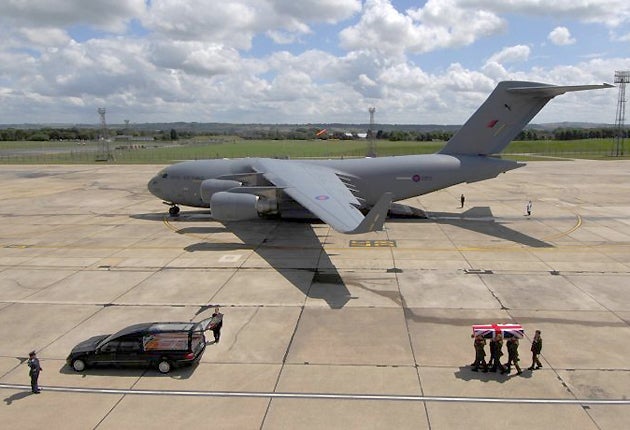Afghanistan: questions of life and death
As eight more soldiers' bodies are flown back to the UK, The Independent tackles the concerns underlying the grief

Q. Why have there been such levels of recrimination over British troop numbers in Afghanistan? What is the situation now?
A. The UK deployment of around 4,000 troops to Afghanistan in 2006 took place against a background of a major commitment in Iraq, with the force there coming under increasing attack from Shia militias. There were deep concerns among military commanders about the strains of "overstretch" and fighting a war on two fronts. Over the three years since, the size of the force rose to the current level of 9,100.
When the UK began withdrawing from southern Iraq, the Americans, who had been against the pullout, wanted some of the forces to be sent to Afghanistan. The Chief of Defence Staff, Air Chief Marshal Sir Jock Stirrup, warned that there could not be "one for one" transfer, but the senior officers, General Sir Richard Dannatt, and his successor in waiting General Sir David Richards in particular, wanted reinforcements of between 2,000 and 2,500 to be sent to Helmand.
The main reasons for the request were that a shortage of boots on the ground meant that strategic ground won from the Taliban could not be held, allowing the enemy to slip back and regain control. There was also the feeling that with up to 22,000 US troops going into the south of the country, including Helmand, the British had to raise their numbers to maintain credibility with the Americans.
A series of options were put before the Government. Gordon Brown, under Treasury lobbying, picked the one involving the lowest commitment: a temporary deployment of 700 for just the period of the Afghan national elections. After the recent controversy over that decision, a review will take place after the election in the Autumn, and it is expected that the temporary 700 would become permanent and an additional force would be sent, numbers yet to be decided.
Q. What has been the British strategy in Afghanistan following the 2006 deployment?
A. John Reid, then Defence Secretary, will never live down saying that he hoped the mission would end "without a shot being fired in anger". Figures vary, but around six million rounds are thought to have been fired in the following three years.
From the start of the mission UK policy appeared to be confused and drifting. The official mission statement was that British troops would help President Hamid Karzai bring governance to a traditionally lawless part of the country and assist in the poppy eradication process. What happened was that British troops charged off to outlying areas and set up platoon houses in effect inviting Taliban attacks. The operation ran counter to a plan drawn up by General (now Sir) David Richards, the British commander of Nato forces, which called for secure areas to be set up around the larger towns, starting with the provincial capital, Lashkar Gar, where reconstruction can begin. Instead, large swathes of Helmand turned into battlefields, and there was virtually no development.
Helmand was responsible for 26 per cent of the national poppy production in 2006. This went up to 44 per cent in the ensuing three years, although there has been a drop in the latest harvest.
Q. Gordon Brown has asked for more Afghan government troops to be based in Helmand. Why? And how effective will this be?
A. It is, of course, the eventual aim of Nato that Afghans will provide their own security. It will be a long time before they are able to. However, the Prime Minister stated that the Afghan forces should hold ground which British forces cannot. In saying so he effectively acknowledged that there are not enough UK forces on the ground.
At present, around 11 per cent of the 85,000-strong Afghan army are based in Helmand, which has seen almost 50 per cent of the recent fighting in the country. But, taken at face value, these figures can be misleading. Much of the Afghan forces are still going through training, and what the British and the Americans have in Helmand are some of the best trained and equipped of that number. Also, the reason that the province is now seeing such a high level of combat is because of large-scale operations carried out by US and UK forces.
The plan is to expand the total strength of Afghan forces to 134,000, and the US want allied countries which have not made troop commitments to the mission to pick up part of the bill. However, even the enlarged Afghan force seems unlikely to be adequately manned to meet a Taliban emergency which is drawing increasing numbers of international jihadists and is supported by elements in the Pakistani military and intelligence service. Iraq, with a not dissimilar population, has a security force of around 600,000.
Q. What about contributions from other Nato countries?
A. No less than 42 countries contribute to the International Security Assistance Force (Isaf) in Afghanistan. Troops include nationals from the United Arab Emirates and Estonia.
But many of the contingents, including those from some Nato countries, operate under caveats which impose severe restrictions on what they are allowed to do on operations – rendering them virtually ineffective in combat scenarios.
The UK and US have repeatedly demanded that other Western states should do more to pull their weight. The worst fatality rate has been suffered by the Canadians, who have lost 126 personnel out of a force of 2,800, compared to 185 British deaths out of 9,000 and 723 Americans from a force of 60,000. The deadliest attack on international forces was on a French unit in August last year; it lost 10 soldiers in an engagement at Sarobi, 40 miles from Kabul.
Join our commenting forum
Join thought-provoking conversations, follow other Independent readers and see their replies
Comments